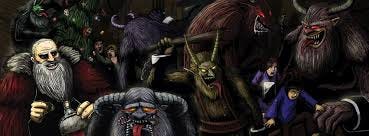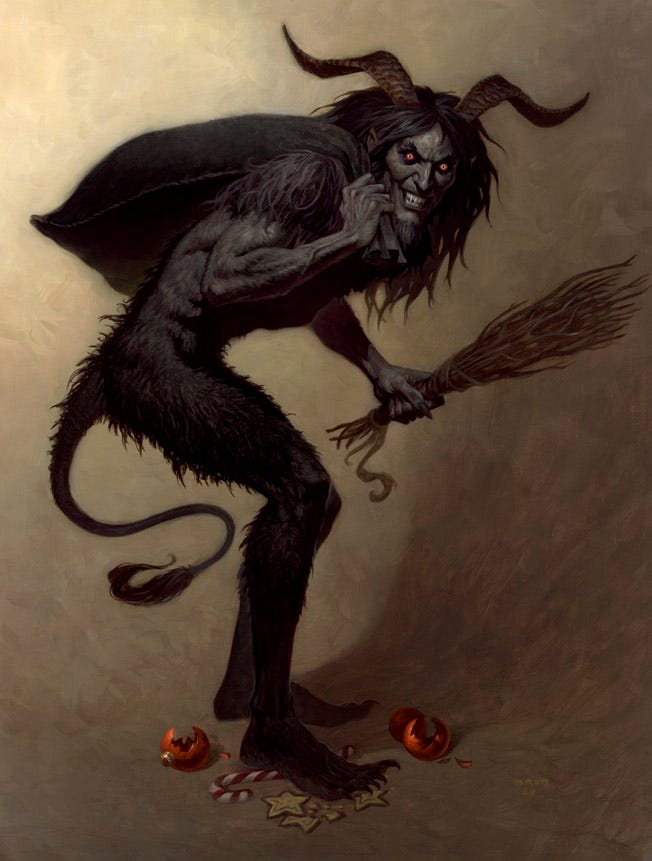Today is the final day of 12 Days of Creepmas! Thank you to everyone who followed this and found our spooky community along the way. To end this series, we are going with my absolute favorite holiday monster, Krampus.
Krampus, the sinister companion of St. Nicholas, has a history that predates Christianity, originating in the Alpine regions of Austria and Germany. Rooted in ancient pagan traditions, Krampus is believed to be the son of the Norse goddess Hel, who herself is the daughter of Loki and keeper of the underworld. His name, derived from the German word Krampen (meaning “claw”), perfectly fits his terrifying appearance and menacing purpose.
What Does Krampus Look Like?
Krampus's look varies slightly depending on the tradition, but the general depiction is universally terrifying. He is a half-goat, half-demon figure with large, curling horns, sharp claws, and a slithering, forked tongue. His body is covered in dark fur—brown or black—and he has cloven hooves. Chains, often adorned with jangling bells, hang from his form, symbolizing either the binding of the devil by the Christian church or the tools he uses to capture naughty children. Adding to the fright, he carries a sack or basket on his back that he uses to cart off his unfortunate victims.
What Does Krampus Do?
Krampus isn't just a random evil entity wreaking havoc; he serves as the dark counterbalance to St. Nicholas. While St. Nick rewards good children with gifts and treats, Krampus deals with the naughty ones in far more horrifying ways. On the night of December 5th—Krampusnacht (Krampus Night)—children leave their shoes outside their doors. Good children wake up on December 6th, St. Nicholas Day, to find their shoes filled with candy and small gifts. Naughty children, however, may find birch rods, or worse—they may be whisked away by Krampus himself.
For especially disobedient children, Krampus goes beyond delivering a warning. Using his chains and basket, he snatches them up and drags them to the underworld for a year of penance. It’s a stark reminder that consequences come for bad behavior, even if it’s an extreme one.
The Role of Krampus in Moral Balance
Krampus is often referred to as the "shadow" of St. Nicholas—the yin to his yang. While some see him purely as an evil figure, others view him as a necessary balance. His presence serves as a grim reminder that actions have consequences, a moral compass of sorts. Sure, his methods are extreme, but the message is clear: behave yourself, or else.
The Krampus Run: A Festive Fright
Krampusnacht isn’t just about leaving out shoes or enduring warnings; it’s also celebrated with events known as Krampuslauf (Krampus Runs). These gatherings, which have been around for over 500 years, range from parades to festivals. Historically, these celebrations involved church plays featuring Krampus masks, but today, they have evolved into elaborate events with participants dressing up in incredibly detailed and often terrifying Krampus costumes.
Modern Krampus Runs vary in intensity. Some towns host tame parades where costumed Krampuses stay behind barricades, creating a family-friendly atmosphere. Others take things to a whole new level, especially during evening festivities for adults. In these versions, Krampuses roam freely, armed with birch rods or whips, playfully swatting at attendees who venture too close. For the brave (or foolhardy), it’s all part of the fun—but let’s be honest, the idea of being chased by a horned, whip-wielding demon is nightmare fuel for many.
Even in the United States, Krampus celebrations are gaining popularity, with events popping up in cities across the country. If you’re not quite ready to face the chaos in person, you can always enjoy the spectacle through movies, documentaries, or even livestreams. Or, for a lighter take, consider picking up Krampus on the Mantle—a devilish alternative to Elf on the Shelf. It’s a fun way to keep the spirit of Krampus alive in a more playful, less terrifying way.
A Lasting Tradition
The legend of Krampus has stood the test of time, evolving yet remaining true to its roots. Whether you view him as a terrifying demon or a necessary counterbalance to holiday cheer, Krampus brings a unique and spooky edge to the holiday season. So, the next time December rolls around, be good—or risk a visit from the claws of Christmas chaos!
Thank you all again for reading. I hope everyone has a safe & happy holiday season. I’ll be back Friday with another Freaky Friday post for all readers! - T




